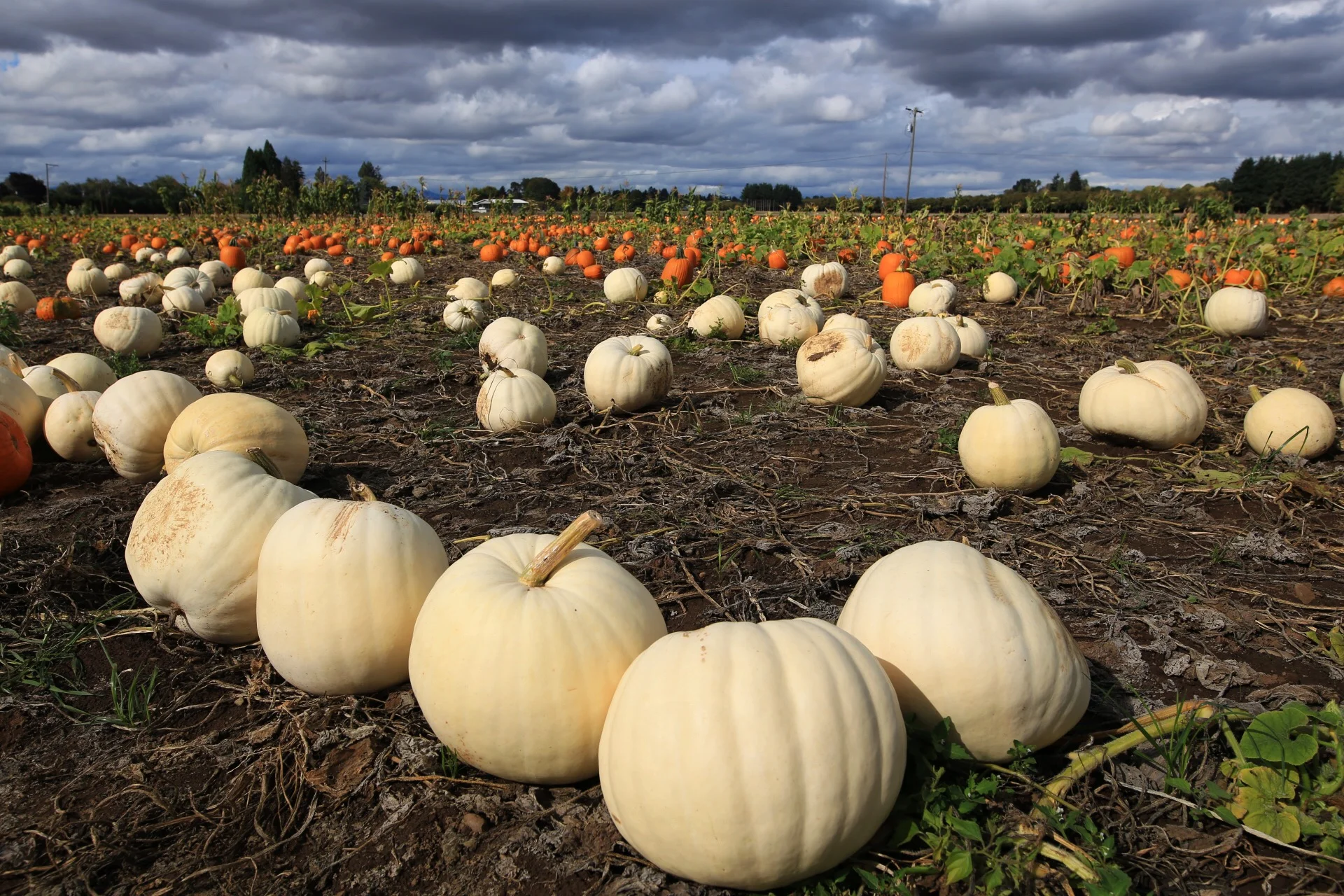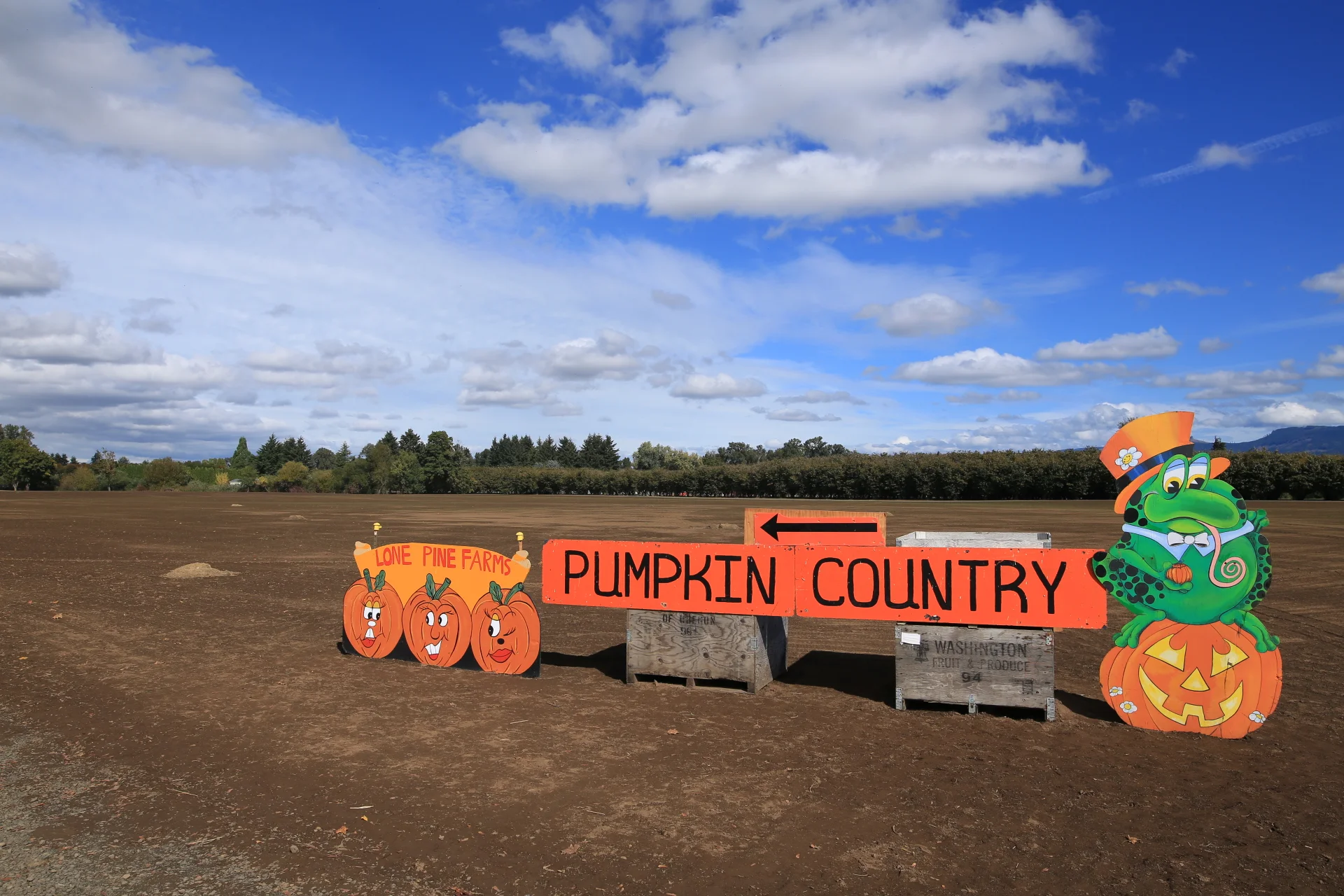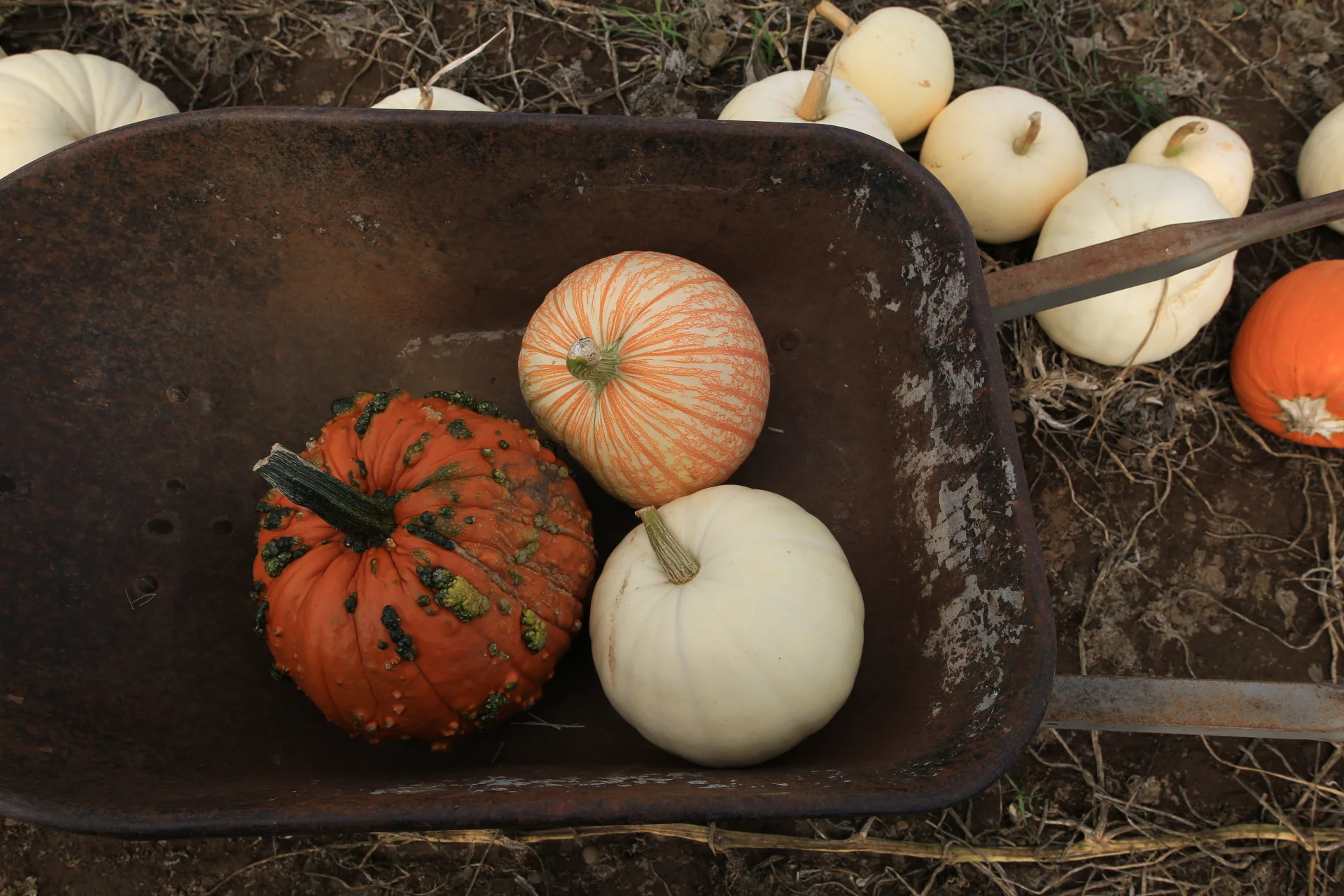THE PUMPKIN PATCH



In one moment, spongey soil quietly beds the cracked gray vines that web so many tiger-orange lumps. In one moment, the sound of perishing sunflowers sloping to the ground combines with the scent of ripe, rotten, and raw pumpkins resting. In one moment, a sticky six-year-old spots a mushy spot on a marmalade pumpkin and attacks. His feet slaughter the once serene growth process like Godzilla entering Tokyo. “This one! This one!” A 10-year-old girl wraps her petite hands around a perfect pearl pumpkin. Families flood the patch like waves washing up on a beach—in and out, loud then quiet. There is a pumpkin for every kid, every mom, every dad, every teenager, every grandparent. Big, small, stout, tall, smooth, curvy, lumpy, light, dark, round, and oblong.
In the Lone Pine Farms annual pumpkin patch, located in Junction City, Farmer Mike Jensen grows a “Magic Pumpkin” for everyone. Visitors come from all over the Eugene area just to feel the spirit of Fall and to find their pumpkin doppelgänger. It’s a place of rituals and traditions that mark the change in season—amber boots and apricot knit sweaters, hot apple cider in thermoses, photographs of assorted stacks of pumpkins. One can discern the memories with every picked up pumpkin. A group of teenagers intending on carving the most ghoulish ghosts onto their Halloween pumpkins, know they don’t celebrate the holiday the same way they used to, but the patch still feels the same. These mystical grounds permeate the sentiment of change and warmth. A couple walks in the patch with a wheelbarrow and families walk out with a wheelbarrow, haphazardly packed with plentiful pumpkins and chaotic children climbing on top, it’s more of a trudge.
MY YOUNGEST BROTHER
Vivian Mora
Daniel Beck walks through life with the confidence of a Wall Street businessman. He has dazzling deep blue eyes and rosy round cheeks that he often uses to his advantage. His smirk is his signature scheming quality.
At three feet tall and five years old, my younger brother Daniel has learned the world does not revolve around him, yet still fights this fact every day; the mornings are systematically traumatizing once he hears it is a school day and then again an hour later when it is time to leave the house.
He reaches nirvana when building Lego spaceships, but refuses to follow the instructions partly because he can’t read (which he would never admit is the reason) and partly because he is the type to go rogue. He would rather go scavenging for food in the kitchen on his hands and knees than let our mom make him food-- he never even bothers to hide the cookie wrappers. Our mom has caught him pants down, peeing in the backyard when someone is occupying his bathroom, but he never even cares to close the backdoor.
Daniel is the sweetest person I know. But similarly to a Sour Patch Kid, he turns bad at any moment’s notice with phrases like, “I want to throw you into the garbage!” I was once sick with the flu and when he found out he ran over to my room, handed me the remote to the living room TV, blew me a kiss, and then played with his Legos next to my bed for hours without a peep.
My brother talks about growing up almost as much as he talks about his Legos creations, he’s going to be a surgeon, so he can help people who are sick, and also cut them open. I don’t know if this career choice will stick, but I do know whatever Daniel wants to do, he’ll find a way to make it happen.
MATT BRUNDAGE AT EUGENE COMIC CON 2016
Vivian Mora
It is rare to catch Matt Brundage alone. Within the first few hours of meeting him, I watched him goof around with his brothers, teach an art class, get anyone and everyone to sing karaoke with him, connect with other artists, and meet a “silly amount of fans.”
Matt is Eugene’s own featured artist at this year’s Eugene Comic Con which brings comic artists from all over the country out to share their work and fans to come admire and interact with it. He is not the stereotypical artist: shy, quiet and likes to be left alone with his art— he is the exact opposite. Matt has an innate openness and desire to collaborate with and inspire other artists, the convention is his place to bring the community together.
Matt is both a muscular man and a goofy-dad—he has three daughters and used to run a gym chain. The day I saw him at the convention, despite his salt-and-pepper facial hair, he was also a kid with ADHD hopping to every booth in sight, introducing himself and giving compliments to other local artists.
“EuCon” is Oregon’s annual comic carnival where a contemporary comic-book culture celebrates at the Lane County Events Center for the creation and consumption of a cult-like art form. The fairgrounds is transformed by a parade of exhibits: actors, artists, writers, business exhibitors, comic books, cosplay, gaming, video games, toys, panels, and art classes.
Attendees are part of the show—most of the crowd came dressed up in handmade character costumes and a real-life R2D2 roamed the floor.
To get a scope of this “carnival” it is best to situate yourself at Matt’s booth—located on the left- hand wall from the entrance doors.
Look to the right at the Seven Feathers Casino corner and you’ll see cosplay characters from Star Wars: The Force Awakens next to blood-splattered pottery mugs with Game of Thrones quotes.
From the booth, you have to make it past a life-sized Chewbacca and all of The Lord of the Rings characters huddled at a collectables booth to get to the Imagination Room—where there is a schedule of free art classes surrounded by circular tables and sandwiched between the exhibition rooms.
Take a left at the vintage comic books of Aquaman to The Savage She Hulk until you hit the rows of other artist booths (the comic books from The Spectacular Spiderman to Zen Intergalatic Ninja continue around the corner). There you see Emmy award-winning artist Keith Tucker to locally known artist Matt Haley to the UO student artists of Art Ducko.
From anywhere, you can see people waiting in line for hours to get an autograph from Supernatural actress Ruth Connell or a picture with iZombie actor David Anders and know it comes from complete devotion.
You are bound to bump into six Harley Quinns and eight Jokers if you want to get to a manga or anime themed booth and you will have your pick from over six artist booths to get a tattoo from.
Go back to Matt’s booth and you will hear him singing “Nights On Broadway” by The Bee Gees and making plans to meet up with newfound artists.
Matt’s openness and integrity are hard to take in because one doesn’t meet the combination very often. At every request I made of him, his response was always, “yeah of course,” or “whatever you need,” and most of the time an enthusiastic, “let’s do it!” These phrases are rotating automated responses for Matt.
Our conversations were almost always while he was drawing or coloring, it was like his sketches relayed all the details of his life to him. After a while I realized, in a way, they did. Every shape, shade and stain on paper is a culmination of his childhood idols and chosen career paths.
Matt used to keep comic books in a dresser drawer. Until one day his mother, who had found “aggressive religion” decided to take them all and burn them in their wood stove: that was the day a thirteen-year-old Matt knew he would become a comic artist.
He laughs at the thought of his mom burning his books and says it was an “I’ll show you” moment of decision and that his mother is actually a loving person. He once told her that this memory molded his path in life and she didn’t even remember it.
Matt got his artistic start at a young age by copying his older brother Paul’s comic drawings.
Matt and his brother would collect the latest Marvel book that week and he would emulate what he saw. The two artists who caught his attention as a kid were John Byrn and George Perez. “These guys were the superstars” of comic books, Matt says, he would pick up anything they drew: The Avengers, Fantastic Four, X-Men.
In high school Matt met “Shane.” He says, “you know when you’re told your whole life how good you are at drawing, then Shane comes along...” Thinking he was the only artist at his school, his friendship with Shane changed Matt’s perspective on comic drawing. He was introduced to the work of “next level artists” like Frank Ferzetta, who Matt still admires to this day for his “cartoony style” and being “the artists’ artist.” He calls Ferzetta “a dirty bugger” for it.
Matt has always surrounded himself with extremely talented artists, he says they are all naturally talented and work hard, but him: he just works hard. “I don’t believe I have the talent thing.” He believes all artists struggle and think they’re not good enough, including himself, but that has never stopped him from pursuing comic drawing. He just can’t stop himself from doing it.
His taste has evolved from superhero comics. His personal style when he isn’t drawing for employers, like Vertigo or DC Comics, is a cartoony-style because “you don’t have to be stuck with hyperrealism, or realism at all.” His favorite stories to tell are ones of his goofy friends from childhood—the ones you still belly laugh from because you it was inappropriate or ridiculous.
Matt also wants the stories he tells to be socially relevant, to spark dialogue and not tell people what to think, but to get people thinking on their own. To learn your own lesson and to be able to have an important conversation with someone about a “fictitious universe” and not have to get into an explicit argument about the current political climate.
Despite the camaraderie at Eucon, Matt describes a community outside of the convention that is self-focused and reclusive.
Matt remembers a visit to a Chicago bar, with a few well-known artists whom he idolized. They all sat in a corner booth drawing on napkins, afraid to talk to girls. “I thought they were going to explode,” from having to be social, Matt recalled.
He prefers to have experiences that are similar to what happened one day in a vegan café in New York City: he sat at a table, colored markers sprawled out, as gradually, nine other artists joined in to share their art, talk about art, and draw together.
Eugene might not stir the kind of drive big cities cultivate and some artists may not feel a sense of community outside of the convention, this is what Matt wants to see change. All he wants to do is recreate a sense of community.
Artists tend to be more introverted, but Matt doesn’t mind being the one to bring people together: “It’s like pulling teeth, but someone’s got to,” he says.
He wants an “artist revolution” that would benefit local artists because they are not good at marketing themselves—they don’t like to show off their work, Matt says.
He has always taken on the role of getting people together and executing plans. He is constantly trying to think of ways to make what we do now better and beneficial for everyone.
He likes to say, “wouldn’t that be great?” after a lofty idea, but there is no doubt Matt has the ability to creatively fix the things he talks about. It is like he challenges you to defend the perhaps broken way we do things now. If artists could get published, but also own their work afterwards, “wouldn’t that be great?”
That is why his dream is to open an art co-op community that goes beyond Eugene. He envisions a big open floor warehouse that is exclusively a hub of art and has the mentality of the well-known Chelsea Hotel, and “a long Viking table where meals are to be had,” as Matt describes.

